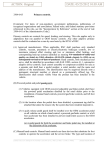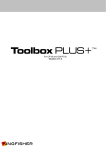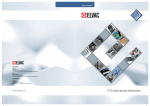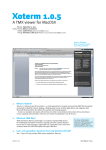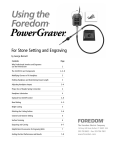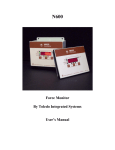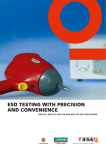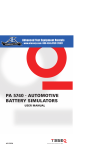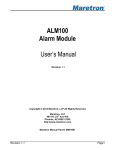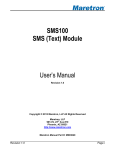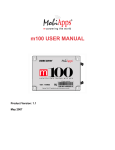Download ACTION: Original DATE: 06/23/2014 4:30 PM
Transcript
ACTION: Original 3304-6-05 DATE: 06/23/2014 4:30 PM Primary controls. [Comment: For dates of non-regulatory government publications, publications of recognized organizations and associations, federal rules, and federal statutory provisions referenced in this rule, see the "Incorporation by Reference" section at the end of rule 3304-6-01 of the Administrative Code.] Primary controls are controls for speed, braking, and steering. This rule applies only to adaptations that run parallel to OEM factory controls. Any other adaptive primary controls shall be evaluated on a case-by-case basis by the RTSU of RSCOOD. (A) Approved manufacturers. When applicable, RSCOOD shall purchase only standard controls, vacuum, pneumatic or electric/electronic brake/gas controls, low or maximum reduced effort steering and low or minimum effort braking, and corresponding back-up systems identified as meeting VA standards of safety and quality as listed in VHA directive 10-94-070 (dated August 5, 1994 or as subsequently revised as of date of purchase). Hand controls, both mechanical and servo, shall be identified in accordance with SAE J1903, section 4.1.1, automotive adaptive driver controls. Each control assembly or component available for sale as a separate unit shall bear a model number, a serial number, and the name and address of the manufacturer. The identification may be engraved directly onto a permanent structural member or placed on a permanently affixed tag. The identification shall remain visible when the product has been installed in the vehicle. (B) Powered pedals and pedal guardguards. (1) Vehicles equipped with OEM powered adjustable gas/brake pedals shall have the powered pedal mechanism disabled by the retail dealer prior to the installation of manual hand controls, powered gas/brake controls, and left foot accelerator. (2) At the location where the pedals have been disabled, a permanent tag shall be attached that states the reason why the system has been rendered inoperative. (3) A quick release pedal guard shall be installed over the OEM accelerator pedal on all vehicles on which a hand control, a powered gas/brake control, or a left foot accelerator has been installed to prevent inadvertent access to the OEM accelerator. (a) A pedal guard for both the accelerator and brake pedal may be installed at the discretion of the evaluator. (C) Manual hand controls. Manual hand controls are those devices that substitute for foot controls to operate the accelerator and the service brake. The type and location of [ stylesheet: rule.xsl 2.14, authoring tool: i4i 2.0 ras3 Jun 17, 2014 09:56, (dv: 0, p: 127657, pa: 227539, ra: 400874, d: 514558)] print date: 06/23/2014 09:03 PM 3304-6-05 2 hand controls shall be determined by the driver rehabilitation specialist in accordance with the consumer's needs to safely and effectively operate the vehicle. The most common manual hand controls are push/pull, push/right angle pull and, push/twist, and rock/push hand controls. (1) Installation requirements. Hand controls shall be permanently mounted only on a vehicle with power brakes, power steering, and automatic transmission. Hand controls shall be installed in accordance with the manufacturer's specifications. (2) Performance requirements. Standard hand controls shall comply with SAE J1903 "Automotive Adaptive Driver Controls, Manual." (a) A hand control shall be accepted when documentation is furnished showing compliance with all sections of SAE J1903. or (b) A hand control may be accepted, at the discretion of the RTSU of RSCOOD, when a visual inspection of an uninstalled control and an installed control is found to comply with all sections of SAE J1903 except sections 4 and 5.4, which are specifications for testing and testing procedures. (D) Powered gas/brake controls. Powered gas/brake controls are add-on parallel controls for throttle and/or brake which are powered other than by the driver's own muscular efforts. The assistance to the driver may be achieved by vacuum, pneumatic, hydraulic, or electric/electronic servos. Powered gas/brake controls shall meet the following specifications: (1) Manufacturers. RSCOOD shall purchase powered gas/brake controls only from manufacturers that have provided the following information to the RTSU of RSCOOD: (a) Name of device; (b) Model number of device; (c) Item description, including general description, purpose of device, and device features; (d) System restrictions and limitations, including: 3304-6-05 3 (i) Restrictions to installation on specific vehicles, and (ii) Incompatibilities (known and probable) with other adaptive driving equipment or with OEM equipment; (e) Limitations/capabilities of intended user population; (f) Current availability of the model: (i) Length of time in production, (ii) Number of units sold to date, and (iii) Customer references, including local/state/federal government and private payers; (g) Status or designation of VA approval, if any; (h) Written signed statement that the design complies with all applicable paragraphs of rules 3304-6-01 to 3304-6-15 of the Administrative Code; (i) Written results of all laboratory, field, and clinical testing as well as data related to compliance pursuant to paragraph (D)(3)(c) of this rule; (j) List of consumer-specific adjustments indicating who shall accomplish the adjustments, that is, the retail dealer, driver rehabilitation specialist, manufacturer, consumer, or other; (k) Maintenance schedule; (l) Warranty documents; (m) Installation/assembly instructions with fully labeled diagrams that specify when factory installation(s) is required; (n) User's manual; (o) Proof of liability insurance as defined in paragraph (I)(1) of rule 3304-6-05 4 3304-6-03 of the Administrative Code. Proof that such insurance remains in full force and effect shall be provided to RSCOOD on an annual basis. The manufacturer shall notify his insurance carrier(s) that RSCOOD shall be notified within thirty days of any reductions in coverage or cancellation. The (p) The manufacturer(s) shall provide an indemnification notice to RSCOOD stating that they shall indemnify and hold RSCOOD, its agents, employees, and consultants harmless from all claims, damages, suits or actions, including any judgments, costs, expenses, and legal fees arising from any modifications made by said manufacturer; and (p)(q) List of approved retail dealer installers. (2) All information provided by the manufacturer shall be considered public information and subject to public information requests. The information shall be reviewed by a team of licensed engineers for approval. All design changes to an approved model shall be reported to the RTSU of RSCOOD. Such design changes shall not be sold to RSCOOD prior to notice, review, and approval. The information that must be submitted for design change review is that indicated in paragraphs (D)(1)(a), (D)(1)(b), (D)(1)(c), (D)(1)(d)(ii), and (D)(1)(h) to (D)(1)(l) of this rule. If the information previously provided for in paragraphs (D)(1)(c), (D)(1)(d)(i), (D)(1)(d)(ii), and (D)(1)(j) to (D)(1)(n) of this rule remains the same as that submitted for the original design approval, the manufacturer shall provide written verification in lieu of resubmitting the requested information. The RTSU of RSCOOD shall determine whether the design change is sufficient to warrant the need for approval as a new product. RSCOOD reserves the right to suspend or withdraw approval without prior notification to the manufacturer if the manufacturer's product is found to be in violation of these rules or is found to involve a significant risk to consumer safety. (3) Performance requirements. (a) Operation. The powered gas/brake control shall have the capability for custom sensitivity settings that can be adjusted by the manufacturer's designee as stated in paragraph (D)(1)(j) of this rule to match the consumer's optimal strength and range of motion and shall have proportional feedback. (b) Testing. The powered gas/brake control shall have pre-check operational capability with visual monitoring and/or an audible and visual warning system in case of malfunction. 3304-6-05 5 (c) The powered gas/brake control shall comply with the following requirements; no exceptions shall be considered, however, a grace period of one calendar year from the effective date of this rule shall be granted for the testing requirements contained in SAE J2603, sections 4.1 to 4.8, 4.10, 5.4.2, 6.1,6.2, 6.3, and 6.7 and SAE J2604, sections 5.1 and 5.2: (i) The items on a completed vehicle shall be inspected for compliance with sections of SAE J2603, SAE J2604, and SAE J2604, section 4, visual inspection of the installed system; (a) SAE J2603, section 4.25, control box connections; (b) SAE J2603, section 4.24, vehicle interface; (c) SAE J2603, section 4.22, attachment; (d) SAE J2603, sections 4.12, compatibility with normal vehicle use; 4.13, injurious exposures; 4.14, operator safety; 4.15, maintenance; 4.16, accommodations for wear; 4.17, environmental resistance; 4.18, mechanical finish; 4.20, cleanliness; 4.21, drivers vision; 4.22 and 4.23, clearance; (e) SAE J2603, section 5.2, protection of hosing and tubing and all sections of SAE J2604; (f) SAE J2603, section 5.4.1, structural fasteners; (g) SAE J2603, section 6.4, warning label and SAE J2604, section 3.3, powered gas/brake control system installation manual; (h) SAE J2603, section 6.6, shutoff; (i) SAE J2603, section 6.8, labeling; and (j) SAE J2603, section 8.1, identification markings and SAE J2604, section 3.7, identification marking. (ii) The owner's manual shall be inspected for compliance with SAE 3304-6-05 6 J2603, section 6.5, users manual and SAE J2604, section 3.2, powered gas/brake control system users manual. (iii) The installation manual shall be inspected for compliance with the following sections of SAE J2603 and SAE J2604: (a) SAE J2603 section 4.9, EMI and SAE J2604 sections 3.3, powered gas/brake control system installation manual and 3.6, other documents; (b) SAE J2603, section 5.5, furnished peripheral components, to be inspected in conjunction with parts list in section 7.4 and SAE J2604, section 3.3 and 3.4, furnished components; (c) SAE J2603, section 5.6, modified OEM parts, to be inspected in conjunction with the parts list in section 7.4 and SAE J2604, section 3.5, modified OEM parts; (d) SAE J2603, section 6.4, warning label (if not on control) and SAE J2604 section 3, receiving inspection and section 4; (e) SAE J2603, section 7, installed manual and SAE J2604, section 3.3. (iv) Other documentation shall be inspected for compliance with the following sections of SAE J2603 and referenced sections of SAE J2604: (a) SAE J2603, section 4.2.1, failure analysis and SAE J2604 section 3.6; (b) SAE J2603, sections 4.9 and 4.10, vibration environment and SAE J2604, sections 3.3 and 3.6; (c) SAE J2603, section 6.5.7, warranty information and SAE J2604, section 3.2; (d) SAE J2603, section 8, markings, recall and NHTSA registration SAE J2604, sections 3.6, and 3.7, identification marking, and section 4. 3304-6-05 7 (v) Documentation of compliance pursuant to paragraph (D)(2) of this rule shall be signed off by a licensed professional engineer and sent to the RTSU of RSCOOD. Verification of compliance shall include observation and inspection of both an uninstalled system and an installed system. (4) The back-up brake system shall have an automatically activated power source to assist in brake application in case of engine failure. (5) When a reservoir tank is needed and supplied, it shall be constructed of a minimum of fourteen-gauge steel or be fabricated of non-corrosive material tested to one hundred fifty per cent of operating pressure. (6) The handle shall have the capability of adaptation for devices that the consumer needs for effective and safe operation. (7) All bearings shall be either sealed bearings, oil-impregnated bronze bushings, or the industrial equivalent. (8) All housings shall be constructed of corrosion-resistant material. (9) Powered gas/brake controls shall not be used in combination with components of another manufacturer's secondary control console or multi-axis remote servo steering wheel controls without the knowledge and permission of both manufacturers. (10) Powered gas/brake control systems shall be in compliance with FMVSS 124, accelerator control systems. The method of compliance shall be provided in detail. (E) Left foot accelerators are devices (consisting only of pedals, extensions, and brackets) that are added to the accelerator pedal to enable a driver to operate the accelerator pedal with the left foot. The left foot accelerator shall be able to be removed and re-installed without the use of tools. This device shall have a permanently mounted base. (F) Pedal extensions. Mechanical, non-powered pedal extensions are add-on devices for use with the original vehicle accelerator, brake and clutch pedals. These devices are used by drivers who can operate the foot pedals, but cannot reach them, or, have difficulty operating the original pedals where they are placed. The pedal extensions should be permanently attached to the original pedal with some type of mechanical fastener (i.e. bolt, clamp, screw, etc.). Or, the pedal end bracket of a quick 3304-6-05 8 disconnect type pedal extension, which may be removed and re-installed in only one set position, should be permanently attached with a mechanical fastener. The mechanical fastener should be such that the pedal extension remains secured and rigid to the original pedal throughout the range of travel of the pedal during use. (1) Vehicles equipped with OEM powered, adjustable gas/brake pedals may need to have the powered pedal mechanism disabled by the dealer if adjustment of the powered pedal causes any binding of the pedal extension mechanism, interference of the pedal and/or extensions, or causes either pedal to be applied, or misapplied, during the pedal adjustment. (2) A separate foot rest may be required for the individual to set their feet on to operate the pedals with the pedal extensions. (3) foot pedal surfaces must be of non-skid material. (4) Installation must meet or exceed the manufacturer's guidelines. (5) Pedal modifications, such as pedal extensions, foot supports, or enlarged pedal surface areas, must be securely attached to the original pedal of the vehicle with a minimum of grade 5 bolt. The type of pedal modification, size and extension shall be determined by the driver rehabilitation specialist. The preference is for a permanently affixed pedal modification, however, the consumer, with full information, may choose a removable device. (F)(G) Braking modifications. Braking modifications lower the amount of driver effort required to operate the brakes and consist of modifications to the vacuum actuated power booster of the stock power brake systems provided as original equipment. This paragraph is limited to modifications which retain a standard brake pedal and associated linkage, the stock master cylinder and all plumbing down to and including the brake wheel cylinders or actuators, and additional equipment which is installed to provide back-up/emergency operation; specifically excluded are power assisted hand controls. (1) The amount of reduction in effort in a low or minimal effort braking system and the pump or tank backup system shall be determined by the driver rehabilitation specialist, based on the consumer's need to achieve safe and effective driving. The retail dealer's bid shall specify the manufacturer and the system that will provide that amount of reduction. (2) An automatically activated back-up system shall be required on low or minimum effort brake systems, and shall provide protection during engine failure. The back-up system shall include a low-vacuum warning indicator. The vacuum back-up system shall utilize a reservoir that meets the requirements of paragraph (D)(4) of this rule. 3304-6-05 9 (3) Any hoses, lines, and fittings shall be of OEM quality and shall meet FMVSS for standard passenger vehicles. (G)(H) Steering devices. Mechanical non-powered steering devices are add-on devices for use with stock automotive steering wheels. These devices are used by drivers who require some assistance in gripping or maintaining contact with the steering wheel with one hand. (H)(I) Steering column extension. A steering column-shaft extension is any elongation of, addition to, or replacement of an OEM steering column so that an individual can reach the steering wheel. A steering column-shaft assembly shall meet the following specifications: (1) A steering column-shaft assembly shall not interfere with the normal collapsibility of the steering column pursuant to FMVSS 203, impact protection for the driver from the steering control system. (2) The length of the assembly and whether it is integral or add-on shall be determined by the driver rehabilitation specialist, based on the consumer's needs to achieve effective and safe driving. The maximum length shall be six inches. (3) That portion of the extended steering column which protrudes above the OEM column cover/housing shall be covered in a manner consistent with the finish and trim of the vehicle interior. (4) Steering column extensions may affect the driver's proximity to secondary switches and their OEM operation. The driver's ability to operate these controls shall be confirmed after the column has been extended. (I)(J) Horizontal steering. Horizontal steering is a replacement steering column that relocates the steering wheel to a horizontal plane. The column is powered up and down to provide access to the horizontal wheel for a driver in a wheelchair. A horizontal steering system shall meet the following: (1) Collapsibility. A horizontal steering system shall comply with FMVSS 203. (2) Positioning. A motorized electrical actuator shall be used to consistently set the steering column head to the proper height. (3) Horizontal steering systems shall only be installed when low or maximum 3304-6-05 10 reduced effort steering and a back-up steering system are also installed. (J)(K) Steering modification. Steering modifications lower the amount of driver effort required to operate the steering system and modify the hydraulic control mechanism of the OEM power steering systems provided as original equipment. This paragraph is limited to modifications to the OEM mechanical steering systems between the end of the steering column shaft and the pitman arm that has an unchanged steering gearbox ratio and to additional equipment installed to provide back-up emergency operation. (1) Steering modifications shall be provided as either low or maximum reduced effort steering systems. The amount of reduction in effort in low or maximum reduced effort steering system shall be determined by the driving rehabilitation specialist, based on the consumer's needs in order to achieve safe and effective driving. The retail dealer's bid shall specify the manufacturer and the system that will provide that amount of reduction. (2) Hydraulic Steering modification performance requirements. (a) Hydraulic Steering modifications shall comply with the following sections of SAE J2672: (i) Sections 1.2, classification and 3, definitions; (ii) The following parts of section 4.0, design requirements, including appendix "A," recommended test procedure (RTP), referred to in parts 4.1, conventional use of motor vehicle; 4.2, mandatory power steering back up system; 4.3.1, maintenance of OEM power steering; 4.4.1, automatic activation; 4.5.4.2, special hydraulic fluids; 4.5.3, pressure maintenance capability; (iii) Section 5.0, materials and components, including the parts of appendix "A," RTP referred to in the parts indicated, except 5.2.4.4, operational testing of fasteners; (iv) Section 6.0, operation, including the parts of appendix "A," RTP referred to in the parts indicated, except the part of 6.2.2.1, warning lamps, which refers to RTP "A" 5.3.3, warning light operation. The inspector shall check the operation of the auditory signal, if used, indicated in 6.2.2, automatic backup activation warning, but need not measure the level of the sound output; and 3304-6-05 11 (v) Sections 7, method of installation and 8, quality control and maintenance. (b) Documentation of compliance with paragraph (J)(2)(a) of this rule shall be signed off by a licensed professional engineer and sent to the RTSU of RSCOOD. Observation and inspection of both an uninstalled system and an installed system meets the requirements for compliance in lieu of bench testing or measurements. (c) The number of turns of the steering wheel shall be the same as the OEM operation. (3) Powered back-up steering shall be installed whenever low or maximum reduced effort hydraulic steering is used. Powered back-up steering for a driver with a disability to compensate for a malfunctioning OEM steering system may be installed at the discretion of the driver rehabilitation specialist. (a) Steering modifications shall comply with the following sections of SAE J2672: (i) Sections 1, scope, classification and limitations; 2, references; and 3; (ii) The following parts of section 4.0, including the parts of appendix "A," RTP referred to in parts 4.1, 4.2, and 4.5, system requirements (reduced effort power steering and power steering backup) and backup systems; (iii) Section 5.0, including parts of appendix "A," RTP referred to in the parts indicated, except for 5.1.2, power steering pump quality, and 5.2.4.4, operational testing of fasteners; (iv) Section 6.2, power steering backup systems, including the parts of appendix "A," RTP referred to in the parts, except the part of 6.2.1, manual operation (override), which refers to RTP 5.3.3. The inspector shall check the operation of the auditory signal, if used, indicated in 6.2.2.2, auditory warning, but need not measure the level of the sound output; and (v) Sections 7.2, power steering and backup systems and 8. (b) Documentation of compliance with paragraph (J)(3)(a) of this rule shall 3304-6-05 12 be signed off by a licensed professional engineer and sent to the RTSU of RSCOOD. Observation and inspection of both an uninstalled system and an installed system meets the requirements in lieu of bench testing. (c) Any hoses, lines, and fittings shall be of OEM quality and shall meet all FMVSS for passenger vehicles. (4) Electronic power steering modification performance requirements. (a) Steering modifications shall comply with any applicable SAE information report, recommended practice or standard as published, or; (b) Manufacturer shall demonstrate component and vehicle compatibility, endurance and capability of the reduced effort electric power steering system and the vehicle(s) it can be installed on. Demonstrations and testing should include (but not limited to) as described in the various SAE publications cited; (i) Operational test of accleerated general endurance of the test vehicle with reduced effort - electric power steering (SAE J2672). (ii) Steering torque/torque output test (SAE J2588 & J2672). (iii) Duty time test (SAE J2672). (iv) Vehicle test - Offset lane change (SAE J2588). (v) Vehicle test - OEM steering test (SAE J2588). (vi) Vehicle test - Reduced effort steering test (SAE J2588). (vii) Vehicle test - Slalom test (SAE J2588). (viii) Bench test - Service life test (SAE J2588). (ix) Bench test - Vibration test (SAE J2588). (x) Electro-Magnetic Interference (EMI) test (SAE J2588 & J1113). (c) Documentation of all demonstrations and/or testing shall be provided to Ohio OOD, for review. (d) Electric power steering backup system requirements. (i) A redundant power supply, i.e. a backup battery, for the reduced effort - electric power steering system shall be provided in case of 3304-6-05 13 the original battery failure. (ii) The failure mode for the reduced effort - electric power steering system, including any failure of the original electric power steering system, shall be to the reduced effort steering mode. (iii) An audible and visual warning device of any failure shall be provided. (4)(5) When the steering has been modified to maximum reduced effort and a steering device is attached to the steering wheel, a counterweight equivalent to the weight of the steering device and any attaching fixture shall be added to balance the steering wheel. (a) This counterweight shall be mounted on the steering wheel directly opposite and one hundred eighty degrees away from the steering device. (b) The counterweight and the steering device shall be removable to permit the vehicle to be driven by a person other than the driver with a disability. (K)(L) Steering wheel devices. (1) The type and location of the steering device shall be determined by the driver rehabilitation specialist. (2) The device or parts of the device shall not interfere with the consumer's ability to view any instrument panel display. (3) The installed steering device shall not interfere with the operation of the air bag system. (4) Steering devices shall be quick release and be easily removable by a person without a disability. (L)(M) Driver training brakes for driver rehabilitation specialists. (1) Driver training brakes shall be securely fastened to the floor of the passenger side of the vehicle. (2) The driver training brake shall not apply any brake pedal pressure until activated by the driver trainer. 3304-6-05 14 (3) All mounting holes shall be filled and sealed when the driver training pedal is removed. 3304-6-05 15 Effective: R.C. 119.032 review dates: 06/23/2014 Certification Date Promulgated Under: Statutory Authority: Rule Amplifies: Prior Effective Dates: 119.03 3304.15(C)(1) 3304.15, 3304.17 09/04/1990, 05/10/1995, 08/02/1999, 06/03/2002, 08/04/2008















